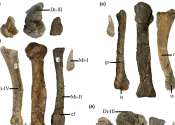UK's oldest human DNA obtained, revealing two distinct Paleolithic populations
The first genetic data from Paleolithic human individuals in the U.K.—the oldest human DNA obtained from the British Isles so far—indicates the presence of two distinct groups that migrated to Britain at the end of the ...









